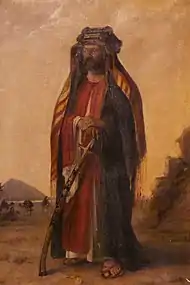Julius Euting | |
|---|---|
 | |
| Born | 11 July 1839 Stuttgart, Germany |
| Died | 2 January 1913 (aged 73) Strasbourg, France |
| Nationality | German |
| Alma mater | University of Tübingen |
| Scientific career | |
| Fields | Orientalist |
| Institutions | University of Strasbourg |
Julius Euting (11 July 1839 – 2 January 1913) was a German Orientalist.
Life


Director of the National and University Library of Strasbourg, he completed his first studies at the Eberhard-Ludwigs-Gymnasium in Stuttgart and at the local seminary . He then studied Theology and Oriental Languages in Tübingen from 1857 to 1861.
Starting in 1867, he made numerous trips to Near and Middle East, especially Syria and Arabia. He worked on the Quran and published numerous bibliographic catalogs. He also published a tourist work on Strasbourg in 1903.[1] He feigned a conversion to Islam, and, just like his colleague Christiaan Snouck Hurgronje, adopted an Arabic name, ʿAbd al-Wahhāb.[2]
From 1876 to 1912 he was President of the Vogesenclub (in French Club Vosgien), on which he wrote a history.[3] This association paid homage to him by dedicating the Tower overlooking the Climont to his name.
Canaanite and Aramaic epigraphy
Euting made a significant contribution to the study of Canaanite and Aramaic inscriptions, particularly those in Phoenician and Punic, becoming the most cited name in the literature of Semitic epigraphy between c. 1875 and 1920.[4] His "Script Tables" became widely renowned among Semitic scholars, and his copy of the Siloam inscription printed at the front of the Gesenius-Kautzsch Hebrew Grammar,[5] has become familiar to generations of scholars in the field.[4]
In addition to his own research, Euting collaborated with other scholars, often publishing articles on inscriptions provided by them or discovered in public collections, including the National Academic Library (Strasbourg). Among his notable contributions was the publications of the Dream ostracon and the Strasbourg Aramaic papyrus (TADAE A4.5 and D7.17), amongst the first known of the Elephantine papyri and ostraca, the Wilmanns Neopunic inscriptions, the Hadrumetum Punic inscriptions, the Tayma stones, the Tamassos bilinguals the Idalion Temple inscriptions, and the 38 Nabataean script funerary inscriptions from Hegra (Mada'in Salih). Euting's publications were widely referenced in the Corpus Inscriptionum Semiticarum (CIS), especially in relation to inscriptions numbered 180-3251, and his "Sammlung der carthagischen Inschriften" (Collection of Carthaginian Inscriptions) and "Punische Steine" (Punic Stones) are considered essential references in the field.[6]
Mark Lidzbarski dedicated his seminal work, the "Handbuch" to both Euting and Theodor Nöldeke.[4]
Publications
Epigraphy
- 1864, Nachrichten über die mandäischen oder zabischen Manuscrr. der kaiserl. Bibliothek zu Paris und der Bibliothek des British Museum zu London', ZDMG 37: 120-36.
- 1867 Qolastā oder Gesänge und Lehren von der Taufe und dem Ausgang der Seele als mandäischer Text mit sämtlichen Varianten, nach Pariser und Londoner Manuscripten, mit Unterstützung der deutschen morgenländ: Gesellschaft in Leipzig, autographirt und hrsg. von J. Euting (Stuttgart: F. Schepperlen).
- 1871 Punische Steine (Mémoires de l'Académie Impériale de St Petersbourg 7/17/3; St Petersburg: Académie Impériale des Sciences).
- 1875 Sechs phönikische Inschriften aus Idalion (Strasbourg: Trübner).
- 1876 Inschriftliche Mittheilungen, Zeitschrift der Deutschen Morgenländischen Gesellschaft 29: 235-40.
- 1877 Katalog der kaiserlichen Universitäts- und Landesbibliothek in Strassburg. Arabische Literatur (Strasbourg: Trübner).
- 1883 Sammlung der carthagischen Inschriften, I (Strasbourg: Trübner).
- 1883 'Epigraphisches', ZDMG 37: 541-43.
- 1885 Nabatäische Inschriften aus Arabien (Berlin: Georg Reimer).
- 1885 Epigraphische Miscellen', Sitzungsberichte der Preussischen Akademie der Wissenschaften: 669-88.
- 1886 Ueber seine Reise in Inner-Arabien. 1883/84 (8. Mai 1886)', Verhandlungen der Gesellschaft für Erdkunde zu Berlin 13: 262-84.
- 1887 Epigraphische Miscellen', Sitzungsberichte der Preussischen Akademie der Wissenschaften: 407-22.
- 1891 Sinaïtische Inschriften (Berlin: Georg Reimer)
- 1896 Tagbuch einer Reise in Inner-Arabien, I (Leiden: E.J. Brill); reprint of the 1896 and 1914 Leiden edition, edited by Enno Littmann, Leiden, 1914 [Reprints u.a. Hildesheim, 2004, ISBN 3-487-12616-8.
- 1903 Notice sur un papyrus égypto-araméen de la Bibliothèque Impériale de Strasbourg (Extrait des Mémoires présentés à l'Académie des Inscriptions et Belles-Lettres; Paris: Imprimerie Nationale).
- 1904 Mandaeischer Diwan nach photographischer Aufnahme, von Dr. B. Pfoertner (Strasbourg: Trübner).
- 1904 ‘Séance du 19 août 1904', CRAIBL: 457-59.
- 1906 ‘Der Kamels-Sattel bei den Beduinen', in C. Bezold (ed.), Orientalische Studien Theodor Nöldeke zum siebzigsten Geburtstag (2. März 1906) gewidmet (2 vols.; Giessen: Alfred Töpelmann), I: 393-98.
- 1909 'Notulac Epigraphicae', in Florilegium ou Recueil de Travaux d'Érudition dédies à Monsieur le Marquis Melchior (Paris: Imprimerie Nationale): 230-39.
- 1914 Tagbuch diner Reise in Inner-Arabien, II (ed. E. Littmann; Leiden: E.J. Brill).
Notebooks
The notebooks from Euting's Middle Eastern travels are held in the University Library of Tübingen:
| Date | Location | Notebooks (Md 676) |
|---|---|---|
| 1869 | Tunis and Carthage | 1 |
| 1870 | Turkey | 2 |
| 1883-84 | Syria and Arabia | 18-23 |
| 1889 | Egypt, Sinai, Palestine, Lebanon | 4-6 |
| 1889-90 | Syria and southern Turkey | 7-10 |
| 1898 | Transjordan (Petra) | 11-13 |
| 1903 | Palestine, Transjordan, Egypt | 14-15 |
| 1905 | Algiers, Tunis | 16-17 |
Other
- Beschreibung der Stadt Strassburg und des Munsters, Strasbourg, 1881.[7]
Notes
- ↑ The 1903 edition was reprinted in 1994 in France under the title La guide illustré de la ville de Strasbourg et de la cathédrale , éditions du Bastion, Strasbourg, 108 pp.
- ↑ Vgl. Christiaan Snouck Hurgronje, „Aus Arabien,“ in Allgemeine Zeitung, November 16, 1885, https://digipress.digitale-sammlungen.de/view/bsb00085480_00281_u001/1
- ↑ Der Vogesenclub und seine Geschichte , Schmidt, Strasbourg, 1881, 18 pp. (excerpt from Mittheilungen des Vogesenclubs )
- 1 2 3 Healey 2023, pp. 316, 327: "Euting's main work was epigraphic. Indeed his name came to be known first by the following generations of Semitists through his Script Tables, which appeared in a variety of publications in the late nineteenth century and are still being reproduced… More familiar in one of the most reprinted of all works in the Semitics field will be Euting's drawing of the Siloam Tunnel inscription in the various editions and translations of the Gesenius-Kautzsch Hebrew Grammar (e.g. GKC). Euting's is the most cited name in the literature of Semitic epigraphy between c. 1875 and 1920: his contribution to the CIS alone was enormous. Emblematic of his significance is the fact that the seminal epigraphic Handbuch of Mark Lidzbarski (Lidzbarski 1898) was dedicated jointly to Nöldeke and Euting. Lidzbarski, in many ways the most important Semitist and epigraphist of the next generation after Nöldeke and Euting, clearly had the highest possible opinion of Euting's contribution to Semitic epigraphy (Lidzbarski 1898: 109).”
- ↑ Gesenius' Hebrew grammar
- ↑ Healey 2023, pp. 317: "Turning to the publication of inscriptions, Euting wrote frequent articles on miscellaneous items given to him for publication by other scholars and in public collections, including the Strasbourg Library. His Notice sur un papyrus égypto-araméen (Euting 1903; see also Répertoire d'Epigraphie Sémitique [RES] 8361) publishes one of the earliest known of the Aramaic papyri from Egypt, predating the major collections published by Sachau. The papyrus is probably from Elephantine and appears to date to 411-410 BCE (see now Porten and Yardeni 1986: 62-65, no. A4.5). Other fragmentary Egyptian Aramaic texts and also Palmyrene inscriptions in museum collections had been published in 1885 and 1887 in the Sitzungs-berichte der Preussischen Akademie der Wissenschaften (Euting 1885b, 1887). In Sechs phönikische Inschriften aus Idalion Euting studied Phoenician inscriptions from Cyprus which he had copied in the British Museum in October 1874 (Euting 1875; see Corpus Inscriptionum Semiticarum [CIS], I, 89-94). He also published Punic inscriptions collected by Professor Wilmanns in North Africa in 1873-74 (Euting 1876), and a miscellany of Phoenician and Aramaic items from Madrid, Cagliari and the British Museum (Euting 1883b; see CIS I, no. 139, II, nos. 49, 53, 64, 84, 102: Euting is acknowledged in relation to II, nos. 49, 53, 102). In 1904 appeared his discussion of a fourteenth-century CE Hebrew synagogue inscription from Tādif east of Aleppo near Manbij/Hierapolis (Euting 1904b): it had been discovered in 1899 by Max Freiherr von Oppenheim who gave the squeeze to Euting (see Euting and Moritz 1913). The contribution Euting made to Phoenician and Punic studies can be gauged from the frequency with which he is named as a source in the CIS I, especially in regard to nos. 180-3251. As many as 367 items from Carthage were taken over from his Sammlung der carthagischen Inschriften (Euting 1883a; see the concordance of numbers at the end of CIS I ii, 558-64). As is clear from the Foreword dated 7 May 1883, the Sammlung volume was consigned to the printers as Euting was about to depart to Arabia. The intention had been to produce another volume later, including translations, and so on, but that never appeared. Other CIS inscriptions come from his Punische Steine (Euting 1871; see CIS I, nos. 166-68, etc.).”
- ↑ Catalogo SUDOC
Bibliography
- Healey, John (2023). "'Sicherheit Des Auges': The Contribution to Semitic Epigraphy of the Explorer Julius Euting (1839-1913)". Law and Religion between Petra and Edessa. London: Routledge. doi:10.4324/9781003420675-10. ISBN 978-1-003-42067-5.
- Hélène Lozachmeur et Françoise Briquel-Chatonnet, "Charles Huber und Julius Euting in Arabien nach französischen, auch heute noch nicht veröffentlichten Dokumenten", Anabases, n. 12, 2010, pp. 195–200.
- C. J. Lyall, «Julius Euting», in The Journal of the Royal Asiatic Society of Great Britain and Ireland (Cambridge), April 1913, pp. 505–510 (necrology).